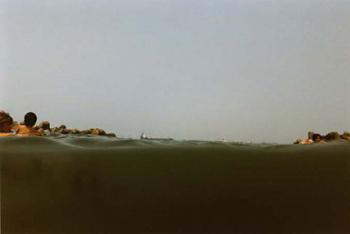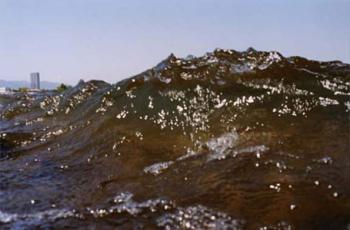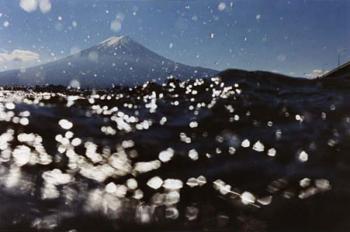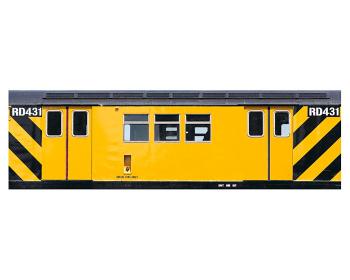NEW YORK—Visiting an air-conditioned galleries is a nice way to spend an August afternoon, especially when the art features views from the ocean or an Antarctic landscape. Several galleries in the city offered the work of visual artists with their own unique perspective.
Photographs by Asako Narahashi at the Yossi Milo Gallery place the viewer not only at sea level but in the sea. Her series of color photographs entitled “half awake and half asleep in the water” shows land from a watery view. The viewer feels surrounded by a dense matter that some would not describe as water. She creates “unexpected relationships between water, land and sky.”
Often the land is a mere line of shapes between a mass of sky and water. Using a Nikon 35mm with waterproof film, Narahashi makes non-digital C-prints whose large size—35”x53”—bring the viewer into the water with the artist.
“Kawaguchiko, 2003” presents a mountain in the background and an even larger mountain of sparkling water in the foreground. “Kushimoto, 2003” contrasts a sky of long, flat clouds and smooth water with the jagged line of irregular rocky shapes in the middle.
The striking piece, “Zeze, 2005” presents a heavy ocean wave, full of intricate shapes and depth, takes up three-fourths of the print while a hazy corner of buildings fall into the background. Harkening back to a certain scary shark movie is “Iwasehama, 2004” that gives a fish’s view of swimmers on floating devices. The water is dark, dense, heavy, with no motion.
The spring-like “Ueno, 2003” gives an idea of what a mermaid might see at the onset of spring. Like Chinese ink drawings that give the heavens the most space, the photograph opens to a large sky with a mass of flowering trees sitting on slightly rippling water. Everything in the piece says Spring.
The Chelsea Art Museum is now exhibiting eight photographs and two silent videos of several days spent in Antarctica by Argentine visual artist Andrea Juan. Also an environmentalist, Juan discovered the effect of methane gases on our coldest continent. She has become “a cultural diplomat for the Poles” organizing symposia, conferences and exhibits.
According to exhibit curator Nina Colosi in an accompanying pamphlet, “She draws the viewer into the Antarctic experience and a perception of the cycle of life that exists between human behavior and the Poles. Juan channels a spiritual connection to nature through her sensual artworks that evoke power and beauty.”
Gallery 225 is now showing photographs of local artists who have their own personal vision of New York City, more specifically Manhattan.
Sarah Weisberg’s Reflection #1 in pink presents a window with a pink frame that reflects three New York skyscrapers in bright sunlight. The window frame softens the hard lines of the reflected buildings yet offers the viewer an idea of their size and mass. Weisberg comments on public and personal spaces. “It’s my love of public spaces and how they relate to the individual reflecting images that are both graphic and magical.” Lucien Flotte’s images are less photographic representations than digital montages of New York architecture. The colors, almost dreamlike, glimmer and shine—something not usually seen in New York’s gray silhouette.
Flotte invites the viewer to look more closely at the urban scene. “The subjects and perspectives of these New York montage images are combined with a digital photo process called High Dynamic Range to capture a photographic tonal range closer to what the human eye can interpret. These photo visions shift reality just enough to intrigue the viewer.”
In spite of its more representational approach, or maybe because of it, the viewer immediately connects with Robin Glasser Sacknoff’s images of the city. “I feel a certain niche for myself specializing in the photography of exotic destinations, fine art, and life on the street.”
Her photograph of the New York skyline at night, glimmering in infinite light, sends out a message of warmth and welcome from the urban nightscape. The diagonal bridge, with its lit curve, is a satisfying part of the composition.
The New York City Library is now displaying images of the city through the eyes of five locally-based photographers. Especially intriguing were those of Ethan Levitas and Bettina Johae. Levitas’s chromogenic images of subway cars, all at the same level and distance, depict people who want to get from here to there. There is a loneliness in the starkness of the train and in the passengers’ faces.
Some cars, in fact most, are grungy as seen in different seasons. The only one in brightly-painted yellow appears new but unoccupied. The loneliness jumps out in the blue-toned images. “I photograph trains as individual subjects whose expression and experience bear witness to a particular time and place.”
Photographer Bettina Johae has created a series of images grouped as boroughs—Manhattan, Queens, Brooklyn, Staten Island, and the Bronx. Because it is an island, Manhattan images are often in relation to its surroundings waters such as the wharves, rivers, bridges. Brooklyn is seen in long shots emphasizing perspective: a huge cemetery, the long curve of a beach, an unending fenceline, a string of condos.
Photographs more immediately connect us with our world and these scenes of vibrant water, hard ice and urban landscapes give us another way to see them.
Asako Narahashi’s photographs were displayed at Yossi Milo Gallery 525 W 25th St. The Chelsea Art Museum at 556 W 22nd is now showing Andrea Juan’s Antarctica Project III Methane. Photographs of Ethan Levitas, Bettina Johae and others were displayed at the New York City Library 476 5th Ave @41st through August.
The spring-like “Ueno, 2003” gives an idea of what a mermaid might see at the onset of spring. Like Chinese ink drawings that give the heavens the most space, the photograph opens to a large sky with a mass of flowering trees sitting on slightly rippling water. Everything in the piece says Spring.
The Chelsea Art Museum is now exhibiting eight photographs and two silent videos of several days spent in Antarctica by Argentine visual artist Andrea Juan. Also an environmentalist, Juan discovered the effect of methane gases on our coldest continent. She has become “a cultural diplomat for the Poles” organizing symposia, conferences and exhibits.
According to exhibit curator Nina Colosi in an accompanying pamphlet, “She draws the viewer into the Antarctic experience and a perception of the cycle of life that exists between human behavior and the Poles. Juan channels a spiritual connection to nature through her sensual artworks that evoke power and beauty.”
Gallery 225 is now showing photographs of local artists who have their own personal vision of New York City, more specifically Manhattan.
Sarah Weisberg’s Reflection #1 in pink presents a window with a pink frame that reflects three New York skyscrapers in bright sunlight. The window frame softens the hard lines of the reflected buildings yet offers the viewer an idea of their size and mass. Weisberg comments on public and personal spaces. “It’s my love of public spaces and how they relate to the individual reflecting images that are both graphic and magical.” Lucien Flotte’s images are less photographic representations than digital montages of New York architecture. The colors, almost dreamlike, glimmer and shine—something not usually seen in New York’s gray silhouette.
Flotte invites the viewer to look more closely at the urban scene. “The subjects and perspectives of these New York montage images are combined with a digital photo process called High Dynamic Range to capture a photographic tonal range closer to what the human eye can interpret. These photo visions shift reality just enough to intrigue the viewer.”
In spite of its more representational approach, or maybe because of it, the viewer immediately connects with Robin Glasser Sacknoff’s images of the city. “I feel a certain niche for myself specializing in the photography of exotic destinations, fine art, and life on the street.”
Her photograph of the New York skyline at night, glimmering in infinite light, sends out a message of warmth and welcome from the urban nightscape. The diagonal bridge, with its lit curve, is a satisfying part of the composition.
The New York City Library is now displaying images of the city through the eyes of five locally-based photographers. Especially intriguing were those of Ethan Levitas and Bettina Johae. Levitas’s chromogenic images of subway cars, all at the same level and distance, depict people who want to get from here to there. There is a loneliness in the starkness of the train and in the passengers’ faces.
Some cars, in fact most, are grungy as seen in different seasons. The only one in brightly-painted yellow appears new but unoccupied. The loneliness jumps out in the blue-toned images. “I photograph trains as individual subjects whose expression and experience bear witness to a particular time and place.”
Photographer Bettina Johae has created a series of images grouped as boroughs—Manhattan, Queens, Brooklyn, Staten Island, and the Bronx. Because it is an island, Manhattan images are often in relation to its surroundings waters such as the wharves, rivers, bridges. Brooklyn is seen in long shots emphasizing perspective: a huge cemetery, the long curve of a beach, an unending fenceline, a string of condos.
Photographs more immediately connect us with our world and these scenes of vibrant water, hard ice and urban landscapes give us another way to see them.
Asako Narahashi’s photographs were displayed at Yossi Milo Gallery 525 W 25th St. The Chelsea Art Museum at 556 W 22nd is now showing Andrea Juan’s Antarctica Project III Methane. Photographs of Ethan Levitas, Bettina Johae and others were displayed at the New York City Library 476 5th Ave @41st through August.

















Friends Read Free